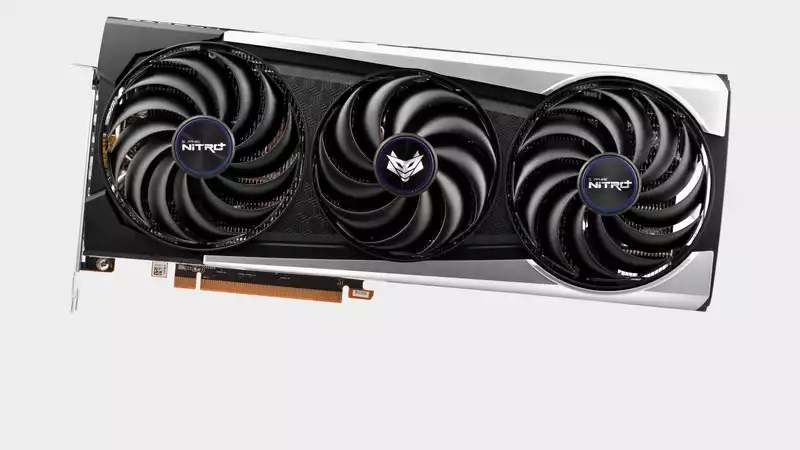Sapphire Nitro+ Say a warm "hello" to the Radeon RX 6700 XT Nitro+. As with all GPUs, there are few available today, and prices have skyrocketed significantly. These woes are not limited to this card, so let's not get too hung up on the market and instead look at how Sapphire compares to other cards in its class. In six months, these market shenanigans and forum discussions will be relegated to the "someday memories" category.
The Sapphire Nitro+ Radeon RX 6700 XT, like all AMD Radeon RX 6700 XT cards, uses the new Navi 22 GPU with 2,560 RDNA2-based shader cores, 96 MB Infinity Cache, plus a 192-bit memory bus connected to 12GB of GDDR6 memory.
This is a narrow bus for a card in this price range, but AMD claims that the large cache minimizes this disadvantage. To be fair, this is exactly what has happened with every other RDNA 2 GPU we've seen: the RDNA2 architecture and 7nm process are showcased in all their glory, with Sapphire running at an astounding 2,622MHz boost clock. AMD is a powerhouse to optimize the architecture to enable this level of clockspeed without resorting to power consumption that could be considered crazy.
The Navi 22 GPU has a relatively modest (by modern standards) 230W TDP, but the Sapphire Nitro+ uses a large 2.5 slot triple fan cooler. The back of the card has a large cutout for airflow, a trend that has become more prominent in recent shrouds; three DisplayPort connections and one HDMI 2.1 port are provided. [There is a nice looking light bar and Sapphire logo on the top of the card, as well as on the back plate. We noted that the card does a good job of producing orange; some RGB products struggle to display accurate orange. However, that is hardly a top selling point. Orange
The PCB is surprisingly compact compared to the cooler, with a 9-phase design capable of delivering up to 300W of power from the 6-pin and 8-pin power connectors. It also has dual BIOS, but both are clocked the same. According to Sapphire, the quiet BIOS lowers fan speeds a bit, but honestly, we couldn't tell the difference between the two; a 350W card might be a bit more practical to use.
There is a third setting that can be toggled using Sapphire's Trixx software app. Additionally, there is an ARGB header that allows other RGB devices to be synced with the card.
Sapphire did a great job with its cooler. The load temperature is only 64°C, which is outstanding for a 230W TDP card. The design is aggressive, with a metal backplate giving it an 80s sci-fi vibe. In addition to the main cooler, Sapphire has added another secondary heat sink to cool the memory. The finned design provides a large surface area, which is thoughtful and very effective.
So what about its performance? To be honest, AMD's pre-launch predictions were a bit rosy. The card is behind the Nvidia GeForce RTX 3070, but we see it being competitive with the GeForce RTX 3060 Ti. Also, the Sapphire card's clock is not improved over the reference card enough to make a meaningful difference in frame rates.
1080p gaming performance
However, any game will run at 1440p and will hit frames at 1080p if driven by a high refresh rate monitor The Nitro+ RX 6700 XT, and all other RX 6700 XT cards, have a noticeable lag in ray There is a noticeable lag in tracing performance, and we will have to wait a bit longer to see AMD's equivalent DLSS implementation. [Unfortunately, however, your choice of cards depends on whether they are in stock the moment you refresh your favorite retailer's page. Winning by one frame or by one frame is meaningless if you can't afford one or the other.
Overclocking GPUs these days is generally not as beneficial as it used to be, but free performance is free, so why not give it a try?
Testing was simple. We increased the power limit to a maximum of +15% and limited memory from the default 2,000 MHz to a maximum of 2,150 MHz. Our sample ran at a set clock of 2,850 MHz, and an actual average clock of 2,765 MHz was observed in a 10-minute 3DMark loop.
Actual performance was measured using Metro: Exodus at 1440p. The default clocked Nitro+ was 70.3 FPS while the overclocked card was 74.6 FPS. This is not an insignificant improvement, but it is not a game changer either.
The Sapphire runs cool and quiet, has 12GB of memory, dual BIOS, a robust PCB, and RGB lighting; it is very capable for a 1440p card and competes well with the RTX 3060 Ti, but its main problem is its MSRP Even if it were, it's the price.
A price closer to the GeForce RTX 3060 would make it a clear winner in the upper midrange segment. But at a base price of $579 (and you'd be lucky to find one at that price), it loses much of its shine; the Nitro+ and most of the other Radeon RX 6700 XTs are actually great small graphics cards, as long as you don't value RT and super-resolution technology too much.
The Nitro+ itself is a very well-made card, but at this price it is hard to compete with the powerful RTX 3060 Ti. Let's see how the market matures in the coming months; the Nitro+ could still be what we consider an attractive mid-range gaming GPU, but it will need a price cut.
.

Comments